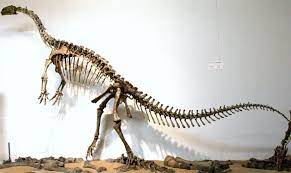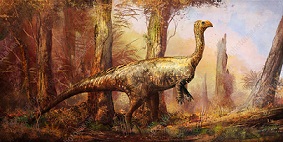
Plateosaurus, a herbivorous dinosaur of the Late Triassic period, represents a crucial transitional form in the evolution of dinosaurs. It belonged to the sauropodomorph group, showcasing features that foreshadowed the giant sauropods of later eras.
Plateosaurus dinosaur that lived during the Late Triassic period, around 214 to 204 million years ago. It belonged to the group of dinosaurs known as sauropodomorphs and is considered one of the earliest and most primitive members of the sauropodomorph lineage.
| Name: | Plateosaurus dinosaurs |
| Size: | Up to 30 feet in length and varied in weight. |
| Main Facts: | Plateosaurus is an early sauropodomorph, showcasing the transition to large herbivorous dinosaurs like Brachiosaurus and Diplodocus in the Jurassic. |
While Plateosaurus primarily moved on its two hind limbs, it could also adopt a quadrupedal posture, especially when feeding or walking at slower speeds.

Plateosaurus was an herbivore, feeding on plants and vegetation. Its teeth were adapted for shredding plant material.
Fossils of Plateosaurus have been found in Europe, particularly in what is now Germany and Switzerland..
Plateosaurus was one of the first dinosaurs to be described scientifically in the early 19th century, contributing significantly to the understanding of dinosaurs.
Plateosaurus shared some characteristics with later, more massive sauropods, such as a long neck and a large body. However, it had a smaller size in comparison.
Evidence of Plateosaurus trackways suggests that these dinosaurs may have moved in groups or herds
Plateosaurus, a Late Triassic herbivorous dinosaur, was a medium-sized sauropodomorph with a long neck, small head, and bipedal stance. It measured up to 30 feet in length and had serrated teeth for processing plant material. Fossils primarily found in Europe reveal its regional distribution. Plateosaurus was an early dinosaur, contributing to our understanding of these ancient creatures, and its existence during a period of environmental changes underscores the dynamic nature of prehistoric ecosystems. It foreshadowed the later, massive sauropods, exemplifying evolutionary transitions within the dinosaur lineage.
Plateosaurus' sauropodomorph features, like its long neck and herbivorous diet, align it with later, larger sauropods like Brachiosaurus and Diplodocus.
Plateosaurus' medium size, with lengths up to 30 feet, contrasts with giant sauropods, illustrating the range of body sizes within the sauropodomorph group.
Plateosaurus' ability to move on two or four legs contrasts with the exclusively bipedal or quadrupedal posture of some other dinosaur lineages, showcasing locomotor diversity.
Plateosaurus' plant-based diet aligns it with other sauropodomorphs and highlights their critical role in shaping prehistoric ecosystems.o
Fossil evidence of Plateosaurus spans Europe, similar to other dinosaur groups like stegosaurs and theropods, revealing regional distributions.
Plateosaurus was among the first scientifically described dinosaurs, contributing significantly to the early understanding of these creatures.
Trackways suggest that Plateosaurus may have moved in groups or herds, similar to the herding behavior seen in some other dinosaur species.
Plateosaurus lived during the Late Triassic, a period marked by environmental changes and extinction events. It eventually became extinct, allowing for the rise of later dinosaur groups.